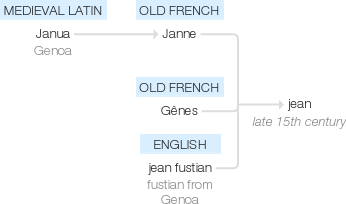Jean
late 15th century (as an adjective): from Old French Janne (now Gênes ), from medieval Latin Janua ‘Genoa’, the place of original production. The noun sense comes from jean fustian, literally ‘fustian from Genoa’, used in the 16th century to denote a heavy twilled cotton cloth.
wiktionary
From the Middle English Gene(“Genoa”), from the Old French Jannes. Bleu de Gênes(“ Genovese blue”) was a blue dye made in Genoa used to tint the denim cloth produced in Nîmes (de Nîmes). Doublet of Genoa and Geneva.
etymonline
Jean
masc. proper name, French equivalent of John (q.v.). The fem. proper name is from the French equivalent of Jane. Related: Jeanette.
jean (n.)
"twilled cotton cloth," mid-15c., Geayne, short for Gene fustian, from French jean fustian "fustian (a type of twilled cotton cloth) of Genoa," the Italian city, from Old French Jannes "Genoa," from Latin Genua (see Genoa). Compare obsolete jane, name of a small silver coin of Genoa that circulated in England 15c. The plural form jeans became standard by mid-19c. In the sense "trousers made of jeans" it is attested by 1908; noted as characteristic of teenagers from 1959. Not originally blue.
After sheep could be protected from the wolves, the people fared better in the matter of clothing. Flannel and linsey were woven for the wear of women and children, while jeans was woven for the men. For want of other dye-stuffs, the wool for the jeans was almost invariably colored with the bark or young shoots of the walnut; hence the inevitable "butternut" worn so extensively in the West for many years. ["History of Menard and Mason Counties, Illinois," 1879]
